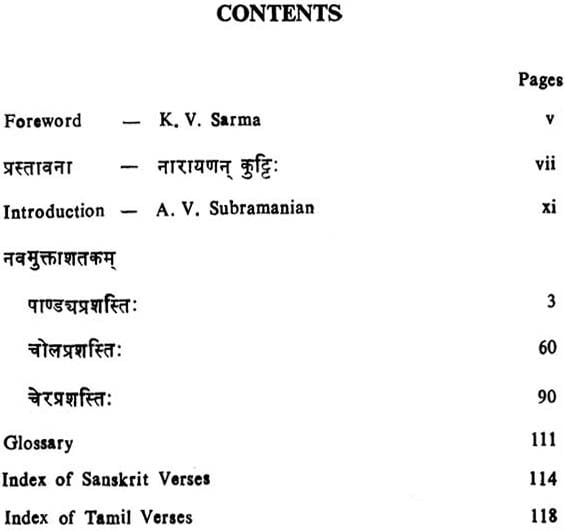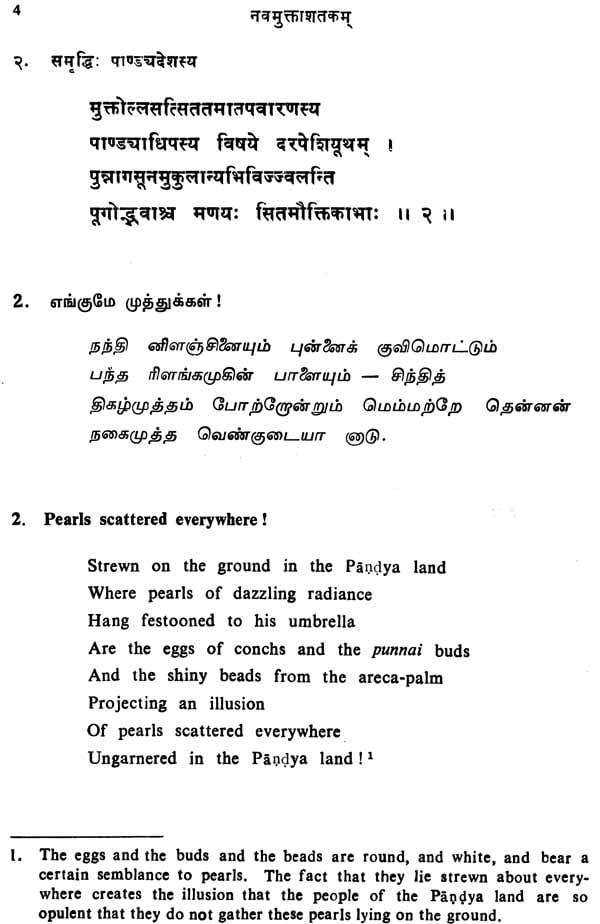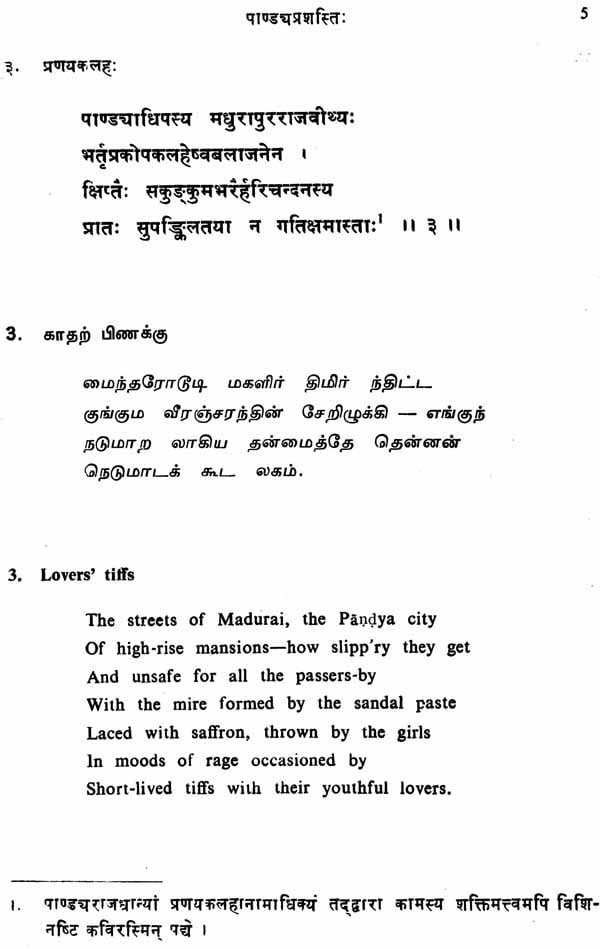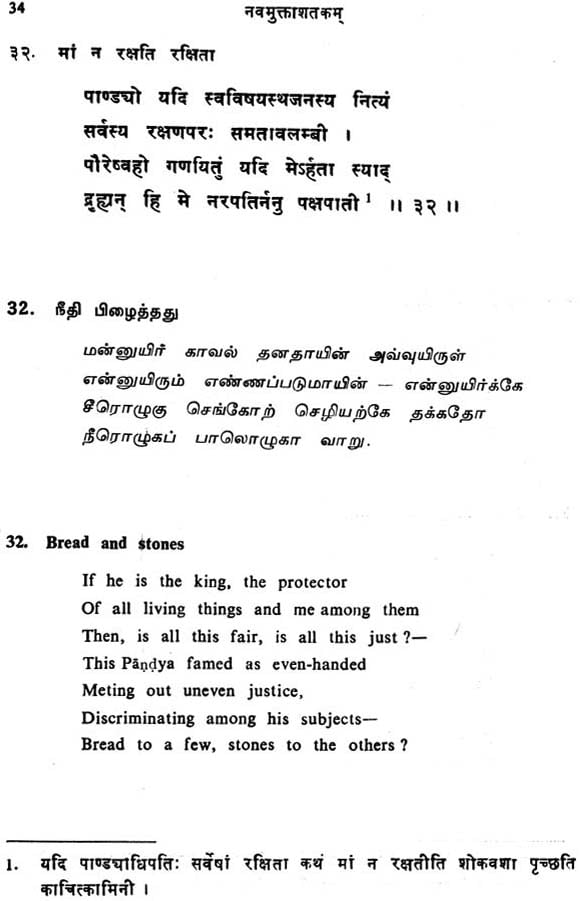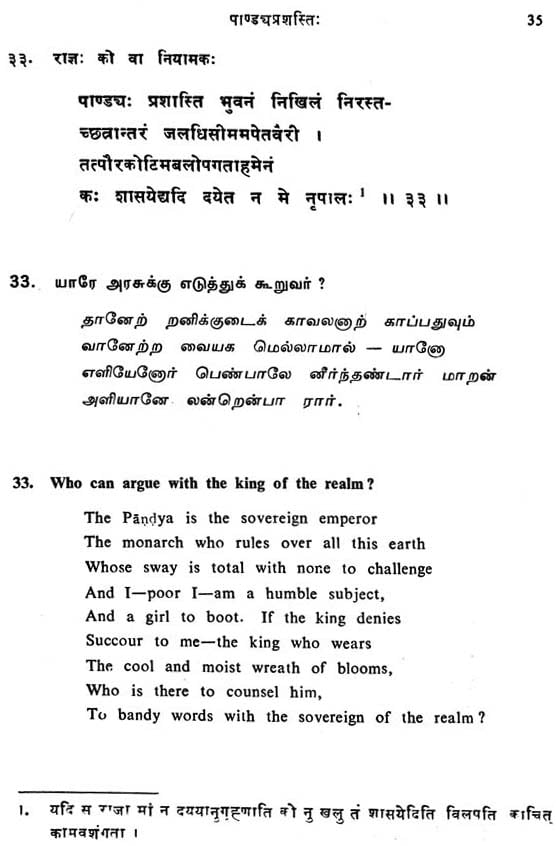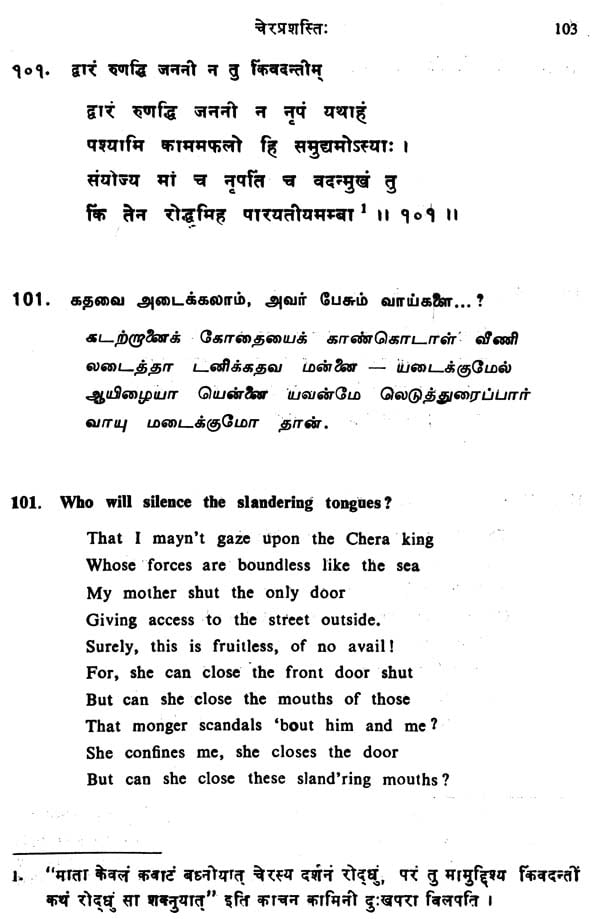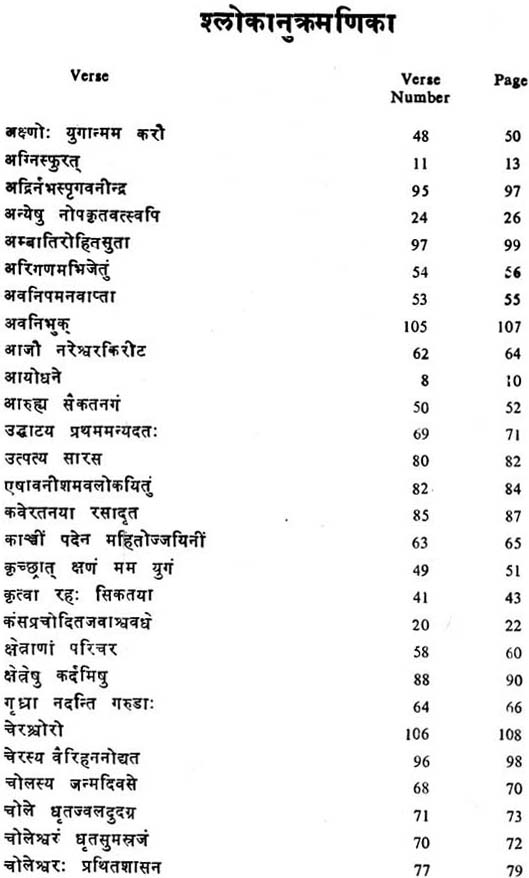
नवमुत्काशतकम्: Muttollayiram -Pearls Thrice Three Hundred (An Old and Rare Book)
Book Specification
| Item Code: | NAP014 |
| Author: | A.V. Subramanian |
| Publisher: | The Kuppuswami Sastri Research Institute |
| Language: | Sanskrit Text with Tamil and English Translations |
| Edition: | 1993 |
| ISBN: | 818517007X |
| Pages: | 148 |
| Cover: | Paperback |
| Other Details | 9.0 inch X 6.0 inch |
| Weight | 230 gm |
Book Description
Navamuktasatakam forms the Sanskrit rendering of a collection of 108 choice verses from early Tamil literature contained in Muttollayiram, a work which belonged to the Later Sangam Period of Tamil classics of the early centuries of the Christian era. Here is an attempts to familiarize the norms and charms of early Tami poetry to student of literature outside the land of the Tamils. An English translation has been provided, also in verse, towards facilitating the understanding of the text. It is interesting that these verses, couched in suggestive and mellifluous words are centered mellifluous words, are centre round the valour, philanthropy and love of the kings of the dynasties which rules the land, the cheras, cholas and pandyas. Provided with an informative introduction, Notes and Glossary, the book is expected to serve its intended purpose exceptionally well.
A.V. Subramanian, who has transcomposed the Tamil Text into Sanskrit and English verse, is a scholar of a rare combination, a master of Sanskrit, Tamil and English, besides being an entertaining speaker on all these three languages. He has researched deeply into the problems of aesthetics and has authored several books which present his innovative ideas, richly illuminated by select quotations from Sanskrit and Tamil literature. His Aesthetics of Wonder, Poetry in Sanskrit and Tamil Literary Genres. The renderings into Sanskrit and English printed in this book speak for themselves. Besides providing pleasing and instructive reading, they make the reader merge in the ethereal world of Tamil poesy, a world of heroism, love humour and pathos.
Forward
The present publication, the result of a unique Endeavour in which an Indian classic is presented in three different languages. The Muttollayiram a work of the ancient Tamil literature is presented in the following pages in its original Tamil, and in two rendering , in Sanskrit and in English , all the three being in the verse form .This endeavor has stemmed out of a decision taken at a meeting of the central Sanskrit board of the government of India which met under the chairmanship of DR.Shankar Dayal Sharma , the present president of India ,at Tirupati held on 15 sept.,1989. The meeting resolved that selection from classic in Tamil and Telgu be rendered into Sanskrit for the edification and appreciation of these classic all over India . The work on Tamil classic was entrusted to the Kuppuswami Sastri Research Institute, Madras at the instance of Dr.S. S janaki , former Director of the Institute , while that on telugu classic was entrusted to the kendriya Sankrit Vidyapeetha, Triupati.
From among the several Tamil Classics , the kuppuswami sastri Research Institute selected three texts , they being the Muttollayiram Purananuru and Kuruntokai , under the said translation scheme. Shri A.V Subramanian, a versatile scholar well versed in Sanskrit , Tamil and English, under look to work on Muttollayiram. And it is gratifying that he himself has rendered the Tamil classic not only into Sanskrit verses, but also into English verses. He has provided the renderings also with an instructive Introduction where in the nature and content of Muttollayiram on the background wherein the nature and content of cussed in detail. A glossary of select terms occurring in the work has also been provided . The Sanskrit rendering has had the benefit of refinement at the hands of Pt. Srinivasacharya , Prof. R Thangaswami.
The Muttollayiram, couched in highly suggestive and mellifluous verses forms exquisite poetry on the valor , philanthropy and love according to the norms of ancient Tamil poetry. it is to be hoped that the present publication will eminently serve the purpose of placing before students of literature some characteristics pieces of ancient Tamil poetry in its original form and through the grab of sanskrit and English.
Muttollayiram , the Tamil classic edited here with translation into Sanskrit and English comprises of a collection of 108 choice verses found quoted at different place in the anthology entitled Pura-t-tirattu.
All these verses from eulogies on the rulers of the three ancient Tamil Kingdom of pandya , cola and cera in south India , suggestive of their qualities of love , philanthropy and valor and have a distinct charm of their own. The translation represent on Endeavour to introduce these pieces of poetic beauty to non Tamil speaking verse, neither their date of composition nor the identify of the poet or the patrons eulogized is known with any certainty. Nor have additional verses over and above the verses dealt with here been discovered in spite of the last two generations of assiduous reasearch since this anthology was edited by Prof. L Vaiyapuri Pillai in 1938 and published by madras university . the only finds have been the identification of some of the self same verses , sometimes with minor textual differences in later commentarial literature in Tamil.
Studies on Muttollayiram verses have shown that they could not have been composed much later then the last works of what is known a 'sangam' age in Tamil literature . Sangam represents , in Tamilology the conclave of poets convoked bye the Pandyas the king of Madurai in south India, for the general encouragement of creative works in Tamil. the conclave seems to have propped for the astonishingly long period of 500 yrs from 300 B.C to 200 A.D., these dates and the duration itself being very much of an approximation . Ettu-t-tokai(eight anthogies) of short poem and Pattu-p-pattu (ten long poems)are the typical products of heyday of this epoch , ate the end of which a series of moralistic codes and few love s peoms came to be composed which are collectively referred to as the Patinen-kil-kanakku.
Its is relevent to mention here that the writing of the sangam are categorised into two types, Akam and Puram . Akam refers to the love motif and 'akam poetry' is governed by set of special conventions ; if theses are contravened in the case of a poem , the poem gets consigned to the puram division , even is it deals with love . The ancient Tamil was Fanatically particular about conformity to these conventions. Puram is a loose term covering all non love pieces and as stated above love pieces too that do not conform to the conventions . war and patronage of arts are the main topics covered by the term puram.
Metre of Muttullayiram
The verses of Muttollayiram are all composed in the venpa metre which is found used in the later works of the Sangam age. its might be noted that Tamil had distinct prosodial structure similar to the system of syllabic matras as in the case of arya or the giti metres in sabskrit.
In tamil the int is called sir which can be represnted by the word 'foot'; this unirt is called regulates all the metres in use in tamil. The earliest metres were asiria-p-pa and kali-p-pa , with the shorter vanci-p-pa , which were not to any regulations concerning the number of line we have verses of 3 lines and poems of 800 lines in the asiria-p-pa . the venpa with which alone we are concern in this work , on the other hand , is a quatrain. Most of the metres which developed later are quatrains too. The kural metre in which the well known tirukkural has been composed has only two lines.
The four lines of the venpa metre have a structure that can be represented as below: 1st line -4 feet 2nd line - 3 feet ,caesura , one foot 3rd line - 4 feet 4th line - 3 feet The assonance in the first two feet is carried to the last foot in the second line. Because of the way last foot of the second line gets chanted as a separate unit after the caesura, poet usually put a term of address there, like ""My handsome friend" or "O friend docked with gold ornaments ". There is an alliteration in every line including the fourth , the first letter of the first foot and the first letter of the 3rd foot being alliterative.
Date of the work
The fact that all the verses of Muttollayiram are composed in the venpa metre and not in the asiria-p-pa or the kali-p-pa is clearly indicative of their period of composition being later that of the first two libraries of the sangam concepts and methods of their presentation , indeed the very manner of the poet handling of the metre are all so similar to the sangam concepts and methods that they should be that which immediately followed it.
There is another subtle device with which to detect the age of a Tamil work. The Sangam Tamils had an almost mystic trust in the efficacy of the characters version , in its overwhelming superiority over the poet version. this is easy to infer from the fact that all their erotic composition is cast in the version of the involved characters without exception. Now, a careful examination of the verses in this work will reveal the striking fact that all the sixty five verses in it which deal with the erotic sentiment are set in the version of poet. Indeed , it will be found that some of the worldly verses in it also (Like 23 and 60) are cast in the version of a character. This strike peculiarity is a strong pointer in the thinking of the present writer , to its early age , an age that cannot be much later that that of works like the Aintnai-aimpadu which constitute members of the Sangam Library of the 'Eighteen later Works'.
Many of the concepts seen in the verses of this work appear to the reader as extension and variations of ideas expressed in the earlier Sangam works . There is reference to the tips of elephants tusks getting blunted through battering the walls and gates of enemy forts in Purananuru; this concept has been worked up to yield a nicely rounded picture in verses no.11 of the Muttollayiram. earliest Sangam works. This indebtedness indicates the later age of this work, that is to say an age later than that of 'Eight Anthologies', believed to be the earliest of the Sangam works .This, verses incidentally , is one of the most beautifully crafted ones in the work where the last occurring at its very end. A similar construction can be seen and enjoyed in stanza 69 where, too the most important word occurs at the very end of the fourth foot with the verb appearing at the very start of the piece. the overall point that is sought to be made in this para is that while the debt owed to the eight Anthologies proves this work to be posterior to them , the fact that the embroidery done on them is not excessive nut a natural step is forward indicate d that its date of composition cannot be very much later.
